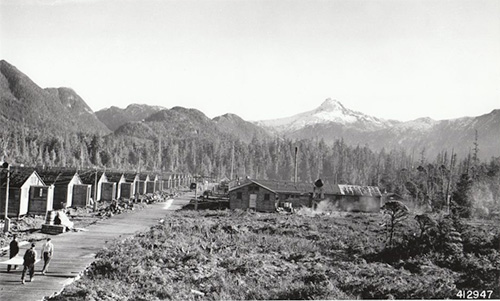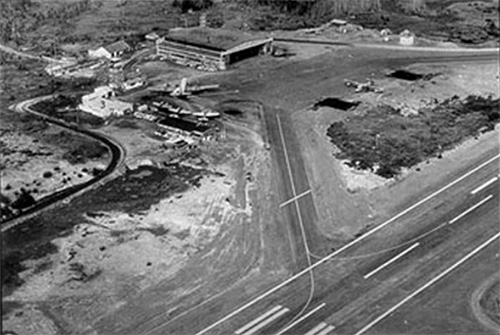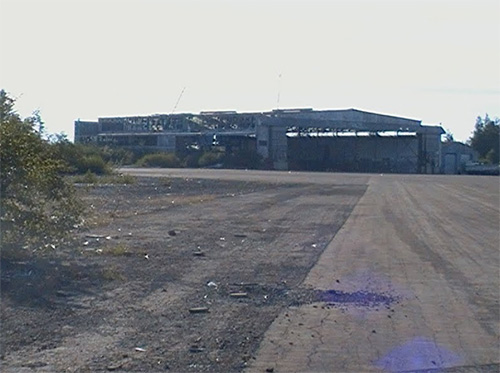
Over Here: When the Canadians came to Annette to help defend Alaska during World War IIBy DAVE KIFFER
March 11, 2018
The Annette Island airport was once the primary way that air passengers arrived in Southern Southeast Alaska from the 1940s to the 1970s. But it also played a significant role in the defense of Southeast Alaska and northern British Columbia during World War II. It was the home of the "first Canadian force ever based in U.S. territory to be tasked with the defense of the United States," according to historian M.V. Bazeau's presentation in the "Alaska at War" symposium in Anchorage in 1993. Plans for the airfield preceded the war. In the 1930s, air travel was growing in the United States and companies had begun service up the Inside Passage from Seattle. Because of the topography, there were few spaces suitable for runways for wheeled planes so most of the planes flying up the coast were sea planes or amphibious ones. Large carriers like Pan Am saw Alaska as a stepping stone to service to Asia and had begun using flying boats to reach Southeast Alaska, but plans were made to build land airports in the region.
The flat muskeg of southwestern Annette Island was a logical spot for a potential airport and the Civilian Conservation Corps - an important 1930s area governmental agency - began working on an airport. Since the land was owned by the Metlatakla Indian Community and was the only tribal reservation land in Alaska, the federal government negotiated a deal with Metlakatla. If the MIC would agree to allow the airfield to be built - on land approximately 10 miles from Metlakatla - then the federal government would build a road across the northern part of Annette Island to facilitate a ferry that could offer better access to Ketchikan, some 20 miles away. It only took the federal government an additional 60 years to make good on that promise! In the years prior to World War II, Alaska's isolation became an issue for the U.S. government and efforts were made to boost the territory's limited defenses. By late 1940 and early 1941, steamship traffic between Alaska and Seattle was at a peak and the U.S. and Canadian governments began discussing ways they could jointly boost their preparations for the war they believed was likely coming. Prince Rupert, with one of the best natural harbors between Seattle and Anchorage was a logical location for a build up, but it lacked an area near by to build a military airfield that could protect the harbor. All eyes shifted north to Annette Island, where the CCC had been attempting to build two large runways in the muskeg. CCC historian Conner Sorenson wrote that the Alaska CCC had been tasked to build a "defense related project." "In August 1940, a twenty man CCC crew from Ketchikan prepared quarters on Annette for the advance crew of army engineers," Sorenson wrote for a presentation at the 1993 Alaska at War symposium. "The main body of CCC enrollees and army engineers (400 of each) arrived later that month. Construction on the island involved the erection of a camp to accommodate 1,200 men and the construction of a five mile truck road to hall rock from a quarry, as well as a pipeline to bring water to camp. Bogs and lakes were filled with rock to provide a solid base for the runway itself." As with many other war era projects time was of the essence. The first plane landed on the not quite complete 7,500 foot runway barely a year later, in September of 1941. A second, 5,000 runway was also completed. When the Japanese attacked Pearl Harbor two months later, work to complete the airfield picked up significantly. With United States air forces - then part of the US Army Air Corps - stretched thin, an agreement was reached with the Canadian government to station military fighters and bombers at Annette. Royal Canadian Air Force squadron No. 115 fighter squadron arrived in May of 1942. "The workings of government are always intriguing - to avoid payment of customs duties on the Canadians' supplies, a special designation of these military units as 'distinguished foreign visitors' was made by the Secretary of State," Canadian historian Murray Lundberg wrote on his "Explore North" history website in 2006. Lundberg noted that air force operations of the 11th US Army Air Force in Alaska spread very thin, at seven different bases ranging from Annette to Dutch Harbor and that the intervention of the Royal Canadian Air Force was a welcome help. By the late spring of 1942, Annette had also become a way station in the endless ferrying of aircraft and supplies farther north. In June, things picked up exponentially when the Japanese bombed Dutch Harbor. Efforts at the Annette field took on more of a military bearing as many in the military and the communities of Ketchikan and Metlakatla became concerned that the air field could provide a temping target if the Japanese decided to occupy more Alaskan territory than the two islands they invaded in the far Aleutians.
But the only "combat" that was reported on or near Annette during the war was the reported "sinking" of a Japanese submarine near Annette by the Coast Guard Cutter McLane on July 10, 1942. The sinking was confirmed by debris and oil near the site of the submarine, but official Japanese records found after the war did not mention submarine activity or losses in Southern Southeast at that time. RCAF historian Larry Millberry wrote about the RCAF's time in Alaska in 1984. "Initially everyone (on Annette)) was quartered in tents, which were adequate, though their oil burners used to freeze up when it got too cold," Millberry wrote " About half-way through the first winter, quonset huts replaced the tents. The camp had a mess where a fellow could get a beer, and this was a real boon to the Americans on the base, whose own mess was dry. Aircraft at Annette were flown and maintained by the Canadians, while US personnel were responsible for all other matters.... Life at Annette was bearable for the Canadians. The weather was generally decent enough for flying... no enemy ships or aircraft were intercepted, but sadly a few aircraft were lost. One P-40 went down after its wings folded during a roll while carrying bombs and F/O Art Jarred, an American, was killed. Another day, a Communications Flight Norseman crashed, killing several base personnel." One sidelight of the frequent reconnaissance flights and other patrols, was the buzzing of the nearby town of Ketchikan. Besides the light bombers, Bolingbrokes, and other larger planes, the fighter pilots were equipped with P-40 Warhawks and British Hawker Hurricanes. Occasionally the pilots would engage in mock dog fights above Tongass Narrows, to the delight of the townspeople below. Both the Canadian and US service personnel were frequently welcomed into Ketchikan where a "canteen" was set up to provide local entertainment for the men, including special "dance" nights in which young - and not so young - women from the community were always willing to take the young soldiers on a spin around the dance floor. The military also attemped to curtail operations on Creek Street in the interests of "national security" during the war years, but those efforts generally proved unsuccessful, although the base commanders on Annette did convince Ketchikan city officials to "limit" the hours of the red light district for several months in 1944.
After the war ended in 1945, the Canadians went home and the military continued to control the airport for two more years. Civilian air traffic picked up with Pan Am and Pacific Northern being the primary airlines to use the facility. Later Western Airlines and Alaska Airlines would also land at Annette. Since Ketchikan did not yet have its own airport, passengers to Ketchikan would transfer from the larger two and four engine planes to smaller amphibians, most notably the Ellis Airlines Grumman Goose and the Consolidated PBYs that had been used by the military during the war. Those passengers would be landed in Ketchikan at docks along the waterfront. In addition to the commercial airline flights, the US Coast Guard operated is primary Southeast air station at the Annette airport until the early 1970s when the air station was consolidated with the facility in Sitka. At its high point, in the mid 1960s, there were more than 100 Coast Guard staff at the air station on Annette. The National Weather Service continued operations at the Annette field after the Coast Guard left. Things wound down on Annette when the Ketchikan International Airport opened on Gravina Island in 1973. But there remained a fair amount of traffic at the old airport on Annette. In 1990, the last year the Federal Aviation Administration kept track, there where more than 8,000 take offs and landings at the Annette airport, many of which were either seasonal visitors to the area or pilots using the empty runways to practice take offs and landings. Over the next couple decades use dropped as the two long runways deteriorated. Although planes still occasionally use the runways on Annette, one of the primary uses today is drag racing by local car aficionados.
On the Web:
Contact Dave at dave@sitnews.us Dave Kiffer ©2018 Representations of fact and opinions in comments posted are solely those of the individual posters and do not represent the opinions of Sitnews.
|
|||||


